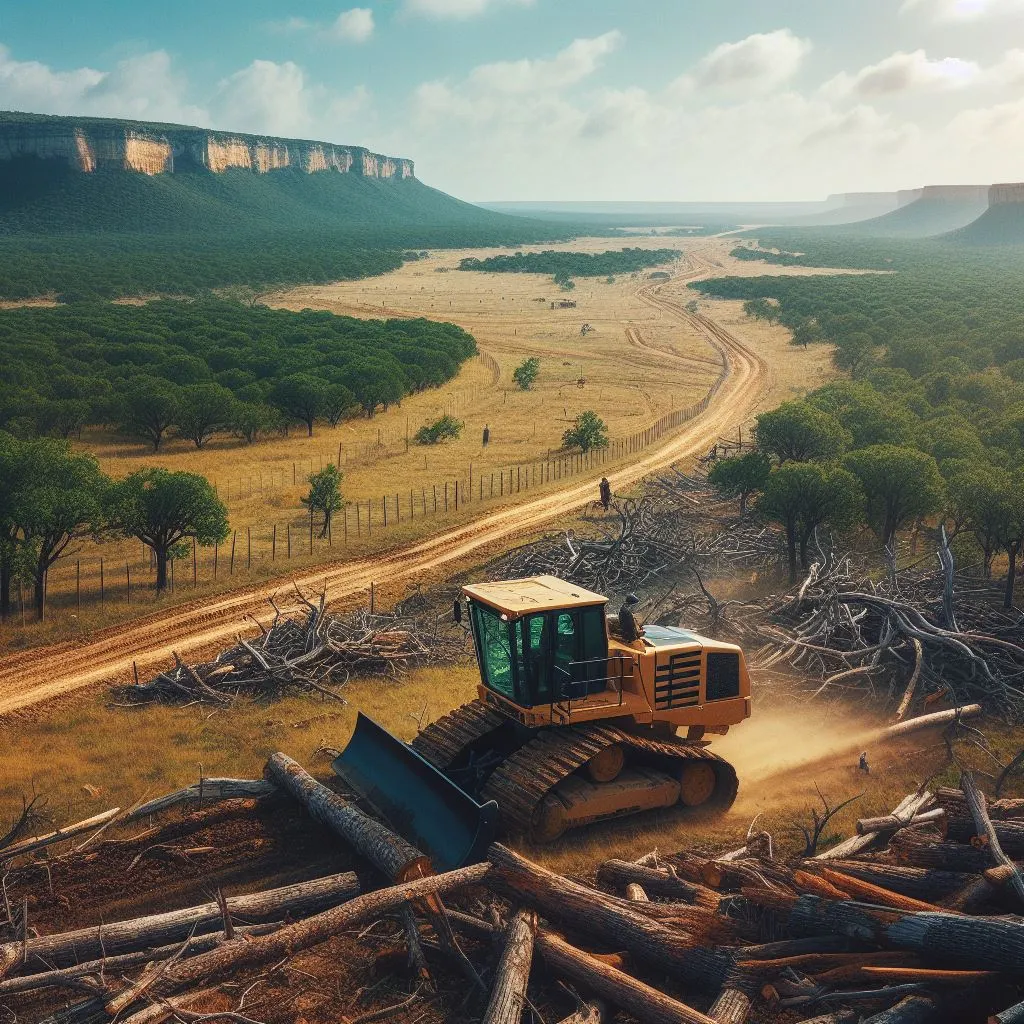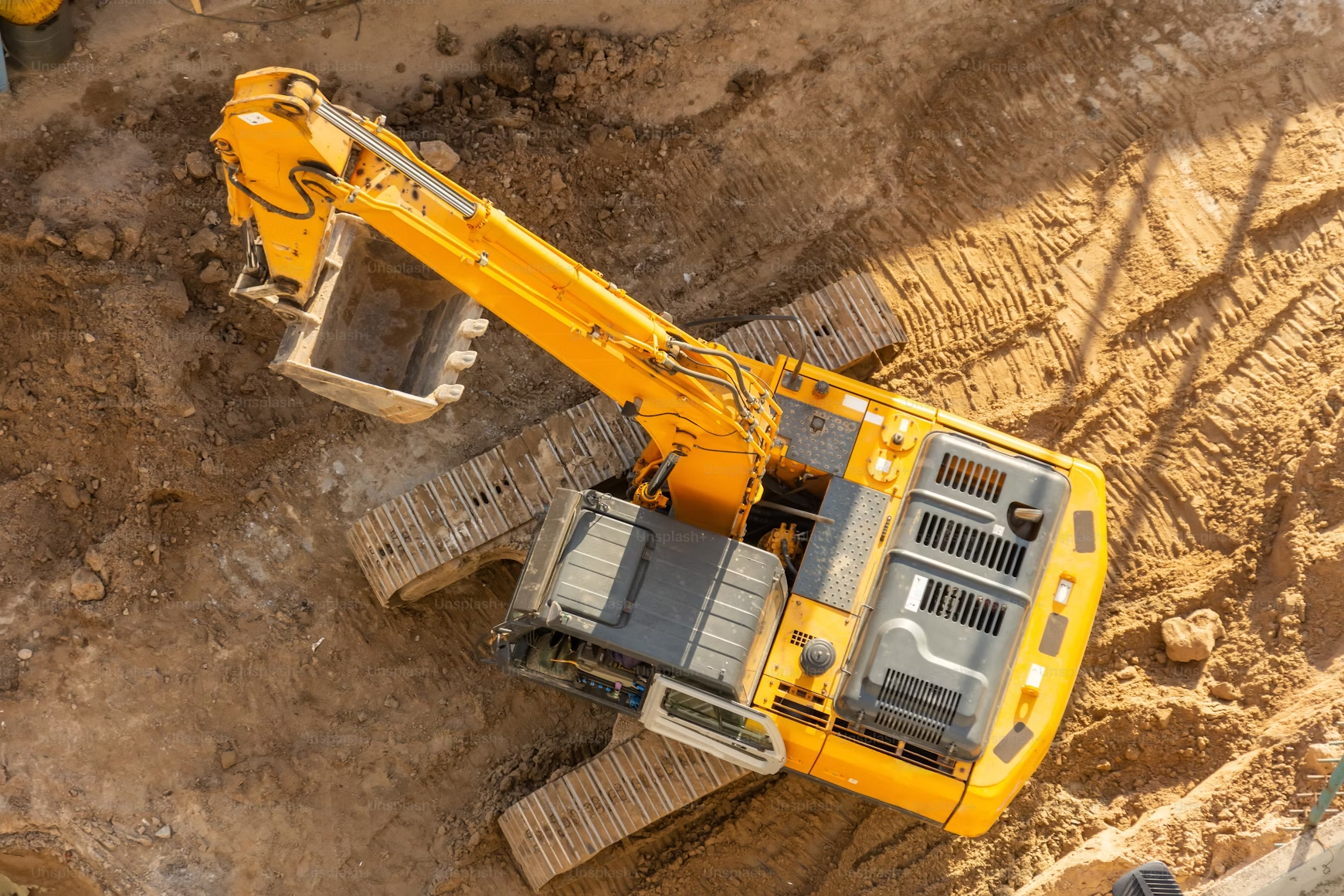Home | How Many Acres Can Be Cleared Per Day?
Land clearing refers to the process of removing trees, vegetation, and other obstacles from a piece of land to prepare it for various purposes such as agriculture, construction, or development. It is an essential step in many industries and plays a crucial role in maximizing productivity and efficiency.
Land clearing is important in various industries such as agriculture, construction, and real estate development. In agriculture, land clearing is necessary to create space for planting crops and improving access for farming equipment. In construction, land clearing is required to make way for buildings, roads, and other infrastructure projects. In real estate development, land clearing is essential to prepare the land for residential or commercial use.
There are several benefits of land clearing. Firstly, it allows for better land utilization by removing obstacles that hinder productivity. By clearing the land, farmers can increase their crop yield and maximize their profits. Secondly, land clearing improves safety by removing hazardous trees or vegetation that may pose a risk to people or property. Lastly, land clearing enhances the aesthetic appeal of the land, making it more attractive for development or recreational purposes.
Key Takeaways
- Land clearing is important for various reasons such as agriculture, construction, and development.
- Factors affecting land clearing productivity include terrain, weather, and equipment used.
- Equipment used in land clearing includes bulldozers, excavators, and mulchers.
- Texas land clearing faces unique challenges such as rocky terrain and environmental regulations.
- Clearing techniques vary depending on the type of terrain and vegetation present.
Factors Affecting Land Clearing Productivity
Several factors can affect the productivity of land clearing operations. These factors include weather conditions, soil type, terrain, vegetation density, and equipment efficiency.
Weather conditions play a significant role in land clearing productivity. Rainy or snowy weather can make the ground muddy or slippery, making it difficult for equipment to operate efficiently. Extreme heat or cold can also affect the performance of machinery and pose risks to workers.
Soil type is another factor that affects land clearing productivity. Different soil types have different levels of compactness and moisture content, which can impact the efficiency of equipment. For example, sandy soil may be easier to clear compared to clay soil.
Terrain is another important factor to consider in land clearing. Flat terrain is generally easier to clear compared to hilly or rocky terrain. Hilly terrain may require specialized equipment or techniques to ensure safe and efficient clearing. Rocky terrain may require additional time and effort to remove obstacles.
Vegetation density is another factor that affects land clearing productivity. Dense vegetation can make it more challenging to clear the land, as it may require more time and effort to remove trees and other vegetation. In some cases, specialized equipment such as mulchers or brush cutters may be required to effectively clear dense vegetation.
Equipment efficiency is crucial in land clearing operations. The type and condition of the equipment used can greatly impact productivity. Well-maintained and efficient equipment can clear land more quickly and effectively, reducing the time and cost of the operation.
Equipment Used in Land Clearing
There are various types of equipment used in land clearing, each with its advantages and disadvantages. The choice of equipment depends on factors such as the size of the land, terrain, vegetation density, and budget.
Some common types of equipment used in land clearing include bulldozers, excavators, skid steer loaders, mulchers, and chainsaws. Bulldozers are often used for large-scale land clearing projects as they are powerful and can push through trees and vegetation. Excavators are versatile machines that can be used for digging, lifting, and clearing debris. Skid steer loaders are compact machines that can maneuver in tight spaces and are often used for smaller land clearing projects.
Mulchers are specialized machines that can grind trees and vegetation into mulch, making them ideal for clearing dense vegetation. Chainsaws are handheld tools that are commonly used for cutting down trees or branches.
Each type of equipment has its advantages and disadvantages. Bulldozers are powerful but may not be suitable for smaller or more delicate areas. Excavators are versatile but may not be as efficient in dense vegetation. Mulchers are effective in clearing dense vegetation but may not be suitable for larger trees. Chainsaws are portable and can be used in various situations but may require more time and effort compared to larger machinery.
When choosing equipment for land clearing, it is important to consider factors such as the size of the land, terrain, vegetation density, and budget. It is also essential to ensure that the equipment is well-maintained and in good working condition to maximize productivity and efficiency.
Texas Land Clearing: Unique Challenges and Opportunities
Land clearing in Texas presents unique challenges and opportunities due to its diverse terrain and vegetation. Texas is known for its vast landscapes, ranging from flat plains to hilly regions and rocky terrains. The state also has a wide variety of vegetation, including dense forests, grasslands, and wetlands.
One of the unique challenges faced in Texas land clearing is the presence of dense vegetation, particularly in forested areas. Clearing dense forests requires specialized equipment such as mulchers or forestry mowers to effectively remove trees and vegetation. The presence of large trees and thick undergrowth can make land clearing more time-consuming and labor-intensive.
Another challenge in Texas land clearing is the presence of rocky terrain. Rocky terrain can make it difficult to clear the land as rocks may need to be removed or broken up before clearing can take place. Specialized equipment such as rock rakes or rock crushers may be required to clear rocky areas effectively.
Despite these challenges, land clearing in Texas also presents opportunities for various industries. The state’s vast landscapes provide ample space for agriculture, construction, and real estate development. With proper planning and the use of appropriate equipment, land clearing in Texas can be done efficiently and effectively.
Clearing Techniques for Different Types of Terrain
Different types of terrain require different techniques for land clearing. Here are some techniques commonly used for different types of terrain:
1. Techniques for flat terrain: Flat terrain is generally easier to clear compared to other types of terrain. Bulldozers and excavators are commonly used for clearing flat terrain. The bulldozer can push through trees and vegetation, while the excavator can dig and lift debris. In some cases, mulchers or brush cutters may be used to clear dense vegetation.
2. Techniques for hilly terrain: Hilly terrain requires specialized techniques to ensure safe and efficient clearing. One common technique is the use of forestry mulchers or mowers that can clear trees and vegetation on slopes. These machines are designed to operate on uneven terrain and can effectively clear hilly areas. In some cases, manual labor may be required to clear steep slopes or inaccessible areas.
3. Techniques for rocky terrain: Clearing rocky terrain requires additional time and effort compared to other types of terrain. Specialized equipment such as rock rakes or rock crushers may be used to remove or break up rocks before clearing can take place. Excavators with rock-breaking attachments can also be used to clear rocky areas.
4. Techniques for wetland terrain: Wetland terrain requires special considerations due to its sensitive nature. In wetland areas, it is important to minimize disturbance to the soil and vegetation to protect the ecosystem. Low-impact techniques such as hand clearing or the use of specialized equipment with low ground pressure are often used in wetland terrain.
It is important to assess the type of terrain before starting a land clearing project and choose the appropriate techniques and equipment accordingly. Consulting with experts or hiring professional land clearing services can help ensure that the right techniques are used for each type of terrain.
Environmental Considerations in Land Clearing

Land clearing has environmental implications, and it is important to consider these factors to minimize the impact on ecosystems and natural resources. Some key environmental considerations in land clearing include the importance of biodiversity, regulations and permits, and best practices for minimizing environmental impact.
Biodiversity refers to the variety of plant and animal species in an ecosystem. Land clearing can have a significant impact on biodiversity by removing or disrupting habitats. It is important to consider the potential impact on wildlife and plant species and take measures to minimize disturbance. This can include leaving buffer zones or preserving certain areas of vegetation to maintain biodiversity.
Regulations and permits are often required for land clearing projects, especially in sensitive areas such as wetlands or protected habitats. It is important to be aware of the regulations and obtain the necessary permits before starting a land clearing project. Failure to comply with regulations can result in fines or legal consequences.
Best practices for minimizing environmental impact in land clearing include using low-impact techniques, minimizing soil erosion, and implementing erosion control measures. Low-impact techniques such as hand clearing or the use of specialized equipment with low ground pressure can help minimize disturbance to the soil and vegetation. Implementing erosion control measures such as silt fences or sediment basins can help prevent soil erosion and protect water quality.
It is important to work with professionals who are knowledgeable about environmental considerations in land clearing to ensure that the project is carried out in an environmentally responsible manner.
Land Clearing Near Me: Finding the Right Service Provider
When looking for a land clearing service provider, there are several factors to consider to ensure that you find the right one for your needs. Here are some factors to consider when choosing a land clearing service provider:
1. Experience and expertise: Look for a service provider with experience and expertise in land clearing. They should have a track record of successfully completing similar projects and be knowledgeable about the specific requirements of your project.
2. Equipment and resources: Consider the type and condition of the equipment used by the service provider. They should have modern and well-maintained equipment that is suitable for your project. Additionally, consider their resources such as manpower and support staff to ensure that they can handle the scope of your project.
3. Reputation and reviews: Research the reputation of the service provider and read reviews from previous clients. Look for positive feedback and testimonials to ensure that they have a good track record of customer satisfaction.
4. Insurance and permits: Ensure that the service provider has the necessary insurance coverage and permits to carry out land clearing projects. This will protect you from liability in case of accidents or damage during the project.
5. Cost and timeline: Obtain quotes from multiple service providers and compare their costs and timelines. However, be cautious of extremely low prices, as they may indicate subpar quality or lack of experience.
Before hiring a land clearing service provider, ask them the following questions:
– What is your experience in land clearing?
– What equipment do you use for land clearing?
– Do you have the necessary permits and insurance?
– Can you provide references or testimonials from previous clients?
– What is your estimated timeline and cost for the project?
Phillips Industries: A Leading Provider of Land Clearing Services
 Phillips Industries is a leading provider of land clearing services with a strong reputation for quality and customer satisfaction. With over 20 years of experience in the industry, Phillips Industries has successfully completed numerous land clearing projects of various sizes and complexities.
Phillips Industries is a leading provider of land clearing services with a strong reputation for quality and customer satisfaction. With over 20 years of experience in the industry, Phillips Industries has successfully completed numerous land clearing projects of various sizes and complexities.
Phillips Industries offers a wide range of services, including land clearing, forestry mulching, brush cutting, and site preparation. They have a fleet of modern and well-maintained equipment that is suitable for different types of terrain and vegetation density. Their team of experienced professionals ensures that each project is carried out efficiently and effectively.
One of the advantages of choosing Phillips Industries is their commitment to environmental stewardship. They prioritize minimizing environmental impact by using low-impact techniques, implementing erosion control measures, and preserving biodiversity whenever possible. They also ensure compliance with regulations and obtain the necessary permits for each project.
Cost of Land Clearing: Factors to Consider
The cost of land clearing can vary depending on several factors. Here are some factors to consider when estimating the cost of land clearing:
1. Size of the land: The size of the land is one of the primary factors that affect the cost of land clearing. Larger areas require more time and resources, which can increase the cost.
2. Terrain and vegetation density: The type of terrain and vegetation density can also impact the cost of land clearing. Hilly terrain or dense vegetation may require specialized equipment or techniques, which can increase the cost.
3. Accessibility: The accessibility of the land can affect the cost of land clearing. If the land is difficult to access or requires additional effort to reach, it can increase the cost.
4. Equipment and resources: The type and condition of the equipment used by the service provider can also impact the cost. Well-maintained and efficient equipment may be more expensive but can result in faster and more efficient clearing.
5. Additional services: Additional services such as stump removal or debris hauling may incur additional costs. It is important to clarify what services are included in the initial quote to avoid any surprises.
It is recommended to obtain quotes from multiple service providers and compare their costs and services. However, it is important to prioritize quality and expertise over cost alone, as choosing a cheaper option may result in subpar quality or additional costs in the long run.
To minimize land clearing costs, consider the following tips:
– Plan ahead and schedule the project during favorable weather conditions.
– Clear smaller areas at a time to reduce costs.
– Opt for low-impact techniques or manual labor where possible.
– Recycle or reuse cleared materials such as wood chips or mulch.
– Obtain multiple quotes and compare costs and services.
Maximizing Productivity and Efficiency in Land Clearing
Land clearing is an essential step in various industries such as agriculture, construction, and real estate development. It plays a crucial role in maximizing productivity and efficiency by removing obstacles and preparing the land for various purposes.
Factors such as weather conditions, soil type, terrain, vegetation density, and equipment efficiency can affect the productivity of land clearing operations. It is important to consider these factors and choose the appropriate techniques and equipment for each type of terrain.
Environmental considerations are also important in land clearing to minimize the impact on ecosystems and natural resources. Regulations and permits may be required, and best practices should be followed to ensure environmental responsibility.
When looking for a land clearing service provider, consider factors such as experience, equipment, reputation, insurance, and cost. Phillips Industries is a leading provider of land clearing services with a strong reputation for quality and customer satisfaction.
The cost of land clearing can vary depending on factors such as the size of the land, terrain, vegetation density, accessibility, and equipment used. It is important to obtain quotes from multiple service providers and compare costs and services.
By understanding the importance of land clearing and considering these factors, it is possible to maximize productivity and efficiency in land clearing projects.
If you’re interested in learning more about land clearing and the efficiency of clearing acres per day, you should check out this informative article from Phillips Industries. They provide valuable insights into the process of land clearing and offer solutions for efficient and effective clearing. To gain a deeper understanding of the topic, visit their blog post on land clearing in Texas.
FAQs

What is land clearing?
Land clearing is the process of removing trees, shrubs, and other vegetation from a piece of land to prepare it for other uses such as agriculture, construction, or development.
What equipment is used for land clearing?
The equipment used for land clearing includes bulldozers, excavators, backhoes, skid steers, and chainsaws.
How many acres can be cleared per day?
The amount of land that can be cleared per day depends on various factors such as the type of equipment used, the density of vegetation, and the skill level of the operators. On average, a bulldozer can clear 1-2 acres per day, while an excavator can clear 2-4 acres per day.
What are the environmental impacts of land clearing?
Land clearing can have negative environmental impacts such as soil erosion, loss of biodiversity, and increased greenhouse gas emissions. It can also lead to habitat destruction and fragmentation, which can have long-term effects on wildlife populations.
What are the regulations for land clearing?
The regulations for land clearing vary by state and country. In some areas, permits may be required for land clearing activities, and there may be restrictions on the types of equipment that can be used and the areas that can be cleared. It is important to check with local authorities before beginning any land clearing activities.
Page design by: Website Creators Near Me






